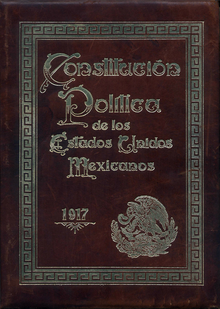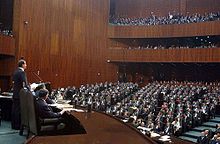Political Constitution of the United Mexican States
The Political Constitution of the United Mexican States was created as a result of the Mexican Revolution , was drawn up by a constituent assembly in Santiago de Querétaro in 1916/17 and ratified on February 5, 1917. It is still in force today but has been changed over 150 times. In the 1990s, Articles 27 and 123 were changed as part of the economic realignment. In addition, the relationship between state and church was reorganized.
Emergence
The Constitution was a compromise verschiedenster interest groups, which is why they anticlerical , national , anti-imperialist , republican , paternalistic and socially - reformist contains items. In addition, there are also liberal elements such as civil liberties , legal security , universal suffrage , which, however, remained limited to men until 1953, the welfare state and the guarantee of private property , whereby other forms of property were also recognized as constitutional. Article 27, the longest article of the Mexican Constitution, grants the state ownership of land and water with the right to transfer management to private individuals and collectives. This article was primarily intended to limit the power of large landowners . A similar goal can be seen in Article 123, which establishes workers' rights. The constitution also contained far-reaching curtailments of the rights of the Catholic Church . This should limit their influence on politics.
content
Mexico is a presidential federal republic under the 1917 constitution . The President is the head of the federal government and at the same time the highest representative of the state. He is directly elected by the people for a single six-year term, the so-called sexenio . The prohibition on re-election is enshrined in the constitution. An early end of the term of office is not provided and only occurs in the event of death. The president has a particularly high level of power. He has the right of initiative in legislative procedures and a veto right on legislative initiatives from Congress. In addition, the President is Commander-in-Chief of the Mexican military and appoints its highest ranks, a number of senior civil servants and the Attorney General . With the approval of Congress and the Council of Ministers, the Mexican President can declare a state of emergency . He has the right to initiate declarations of war , sets the guidelines for foreign policy and signs international treaties.
The Congress of the Union of Mexico ( Congreso de la Unión ) is divided into two chambers. The House of Representatives has 500 members, the Senate consists of 128 senators. The 500 MPs are elected every three years. 300 of them are in a direct dial ( Personenwahl determined), 200 over list positions ( majority vote ) selected. The senators are elected for six years. In each of the 32 states three senators are appointed, two of them by majority vote , the third senatorial post is awarded to the strongest opposition party. The 32 remaining senatorial seats are awarded nationally according to a proportional representation system. Like the President, MPs and Senators may not be re-elected after their term of office. The most important function of the House of Representatives is the annual examination, discussion and approval of the federal budget , whereby a rejection is not planned. The most important powers of the Senate, on the other hand, are the approval of international treaties and the authorization of the deployment of troops abroad. In addition, the areas of responsibility of the congress are the enactment of laws and decrees, the economic, territorial and political organization of the country, the approval of declarations of war, promotion of education and labor legislation.
The governors of the states are directly elected by the people, but are severely limited in their scope of action and rely on the goodwill of the president.
The Supreme Court of Mexico is the Suprema Corte de Justicia de la Nación . It is made up of eleven federal judges (ministros) who are proposed by the president and confirmed by the senate. Their term of office is limited to 15 years, the president of the court is appointed from among their number for four years and may not be re-elected directly afterwards.
Individual evidence
- ↑ a b c Klaus Stüwe (ed.) And Stefan Rinke (ed.): The political systems in North and Latin America. An introduction. VS Verlag für Sozialwissenschaften, Wiesbaden 2008, ISBN 978-3-531-14252-4 , p. 392.
Web links
- Niemeyer, E. Victor, Jr. Revolution at Querétaro: the Mexican constitutional convention of 1916-1917 Austin: University of Texas Press, c1974. ISBN 0-292-77005-7
- Text of the Constitution (Spanish)


